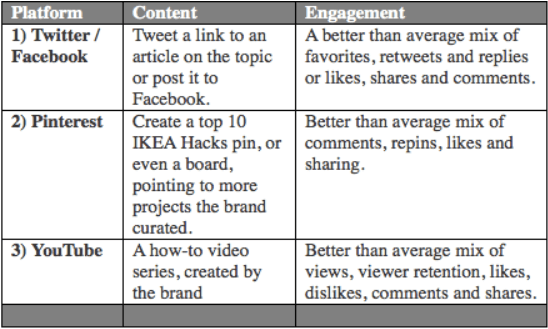Four tips to help you create content in a tl;dr world. How well did I communicate my topic in that headline?
Have you ever thought about why certain headlines appeal to you while other’s don’t?
According to Outbrain, my headline is just barely long enough.
After serving up hundreds of thousands of stories, the content discovery platform knows we’re more likely to click through headlines with 12 to 18 words in them.
The need to apply science to the art of headline writing when you create content is a minor industry symptom of a more serious and far-reaching disease: The consumer’s ever-shrinking attention span.
The average attention span is a mere eight seconds.
And if this doesn’t seem short, consider the goldfish clocks in at nine seconds.
How to Communicate While Marketing in a World of Brevity
And, more troubling, mobile makes our eight-second window of opportunity seem even smaller.
When we create content, it must be mobile-friendly, easy to access, consume, and share during in-between moments such as riding on an elevator or waiting for a meeting to start.
We even say something is tl;dr because, evidently, saying it was “too long, (so I) didn’t read” is too cumbersome. This doesn’t mean we should relentlessly shorten the length of every message we publish.
Consider these four tips to help you create content in a world of brevity.
Build a Plan with Cobblestones and Cornerstones
One issue with going tl;dr on messaging is ensuring it all rolls up into a broader plan. The concept of cobblestones and cornerstones can help make this happen.
When the Star Wars franchise first started to tell its story, George Lucas already knew all six chapters.
He also knew the entire story was too long to tell in a single movie. So, while he started with one cobblestone, he always had the bigger cornerstone in mind.
Consider how key editorial cornerstones can support your longer, broader plan when you create content.
Then atomize these cornerstones into as many pieces of content, or cobblestones, as the plan warrants.
BuzzFeed took this approach, at a tactical level, when it wanted to communicate to potential advertisers how technology is changing media.
The publisher knew some funny .gifs, or a quiz wouldn’t get prospects to part with ad dollars. To create content advertisers cared about, they built BuzzFeed Insights.
BuzzFeed atomizes a white-paper-sized story into four trend-focused stories. Each story is a cross between a blog post and an infographic.
The single-page site gets the broader message across and its execution reinforces the BuzzFeed brand.
Use Data to Make it All Relevant
Stories must engage the audience and help a brand reach its business goals—all without mentioning the brand!
When you create content, a story’s role in connecting brands to consumers can seem unrealistic. But data can help any editorial strategy meet these seemingly contradictory requirements, and help you communicate with consumers more effectively.
A variety of data sources can help—from internal data such as web analytics and customer service inquiries to external data such as search queries and social conversations.
This informed approach to helping you create content is why I can advise almost any consumer packaged goods (CPG) brand to include a story with a slow cooker recipe in their editorial calendar.
Search queries, social data, and web analytics have shown the boring crock-pot’s convenience and simplicity make it a well-performing topic, regardless of the season.
And data can fuel more than the launch. It should also be used to optimize each wave of stories, ensuring they only improve in effectiveness.
Create Content Where Story Drives the Form
When you create content, it relies on data science, but the process is a mix of art and science.
Content created with a science-only approach is bad enough that parody sites such as Clickhole have emerged to poke fun at this faux pas.
But a simple, three-word mantra can keep your left-brain on the right track: Story Drives Form.
This means: Focus on the story first and then consider how you wish to communicate it. When you sit down to create content, as yourself, “Should it take the form of a video, an infographic, or a more traditional article?”
- Short-Form Video: Any story where seeing is believing may seem a fit for video. But keep in mind short stories with a high level of utility or entertainment value tend to work hardest.
- Visual Infographic: This easily shared format is great for several quick factoids or a story with a handful of numbers. If you have a text-heavy message? Think again.
- Long-Form Editorial: A complex topic isn’t a bad thing if it’s of interest to your audience. It may warrant a longer article, a white paper or even a series of articles to tell the right story.
There are no hard and fast rules here–it is the art of story creation after all. But by focusing on the story first, the right form should become clear.
If someone starts a project form first, without an idea of the story to tell, it’s understandable. Try shifting the focus back to the story before deciding which form it will take.
And remember that taking a cobblestone and cornerstone approach means it might take all three of the above examples, working in concert, to tell a single story.
Test Short-Form to Decide When to Go Long-Form
The tips to create content so far focus upstream on the planning stages. But in the thick of a plan’s execution, we may need to decide how many stories are needed on a certain topic to help us reach our goals.
This is especially true if you’re using data to optimize your content.
Testing small pieces of content on social platforms is one way to do this. More time and resources can be invested in a topic based on the levels of engagement these smaller stories receive.
Let’s say a CPG brand is publishing content for the do-it-yourself consumer. A story they find on how to up-cycle IKEA furniture sounds like the perfect topic.
So take the following steps to test audience interest before creating new content around it.
Insights from the planning data may support the decision to create the video series, but this process reconfirms demand for a specific topic before investing in content creation to support it.
Attention spans will continue to shrink. But the audience will always dedicate time and attention to relevant and engaging content.
We must do more than shrink our content down to bumper sticker phrases and one-line church sign wisdom.
We must be smarter about how we create content, as a whole.
Photo credit: Shutterstock

